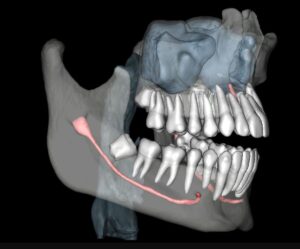Wisdom Teeth Removal Expectations – Part 2
Why is the 3D Cone Beam CT Scan so Important?
In my previous blog, I discussed wisdom teeth removal expectations. It starts with a consultation and evaluation. Then, we take images of your teeth with a 3D Cone Beam CT Scan.
While this technology only uses a small about of radiation (about the same amount as being in the sun for two hours and much less than a conventional set of dental X-Rays), it generates 360-degree images of the teeth. This allows me to do three-dimensional reconstructions of the wisdom teeth and the structures surrounding them. In fact, we are one the the first centers in the nation using this A1 technology to enhance the images we can obtain with your scan.
But why is this superior view vitally important?
The superior view is vitally important due to the fact that wisdom teeth don’t simply sit in the jawbone like an island. There are other structures in the area that need to be considered prior to removing the wisdom teeth.

For example, sinuses are situated just above the upper wisdom teeth, and some people have wisdom teeth that actually protrude into the sinuses. When this is the case, removing the wisdom teeth can create an opening from the sinus to the mouth via the tooth socket. While this sounds like a very bad situation, having the full picture allows us to deal with this event fully.
To elaborate, some patient’s upper wisdom teeth will position themselves away from the sinuses as they develop, and through three-dimensional reconstruction, I can determine whether it would be beneficial to leave things alone and allow for that to happen.
If, however, a patient has wisdom teeth that are already fully formed and protruding into the sinuses, then I will know this in advance and therefore be prepared to plug and seal the opening that will develop during the wisdom teeth removal procedure.
When viewing the lower wisdom teeth, there aren’t any sinuses to worry about, but there is a nerve called the inferior alveolar nerve that needs to be considered. This nerve tunnels just below the lower teeth, travels through the lower jawbone, comes out near the eye tooth, and then goes into the lip. It gives feeling to the lip, cheek, tongue, gums, and teeth.
Depending on an individual’s anatomy, there can be a very close relationship between the root of a lower wisdom tooth and the inferior alveolar nerve. If this is the case, then removing a lower tooth could lead to permanent loss of feeling or a permanent sense of tingling in the lip, cheek, tongue, gums, and teeth.
Use of the three-dimensional Cone Beam CT Scan allows me to understand the relationship between the tooth and the nerve and determine whether it is safe to remove the lower wisdom tooth.
In some cases, extraction may carry too high of a risk, in which case my recommendation would be to forego extraction (unless the patient’s situation requires action).
I’ll discuss another option and more about wisdom teeth removal expectations in my next blog…
In the meantime, click here if you want to learn more about TheWisdomToothDoc™ wisdom teeth removal process without opioids, contact us here to schedule your initial consultation.